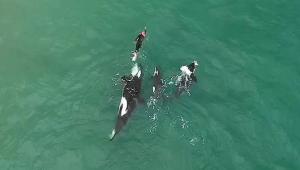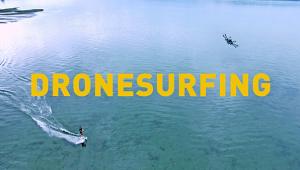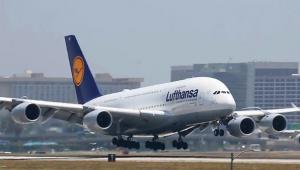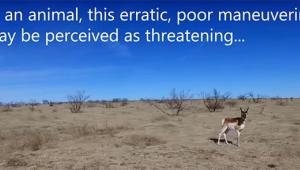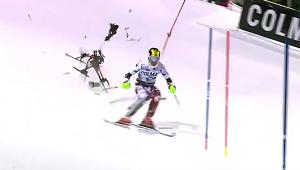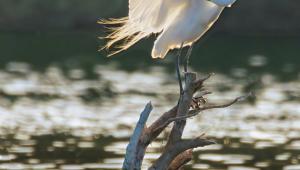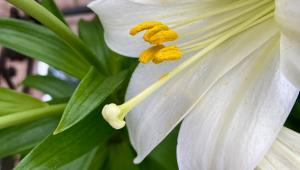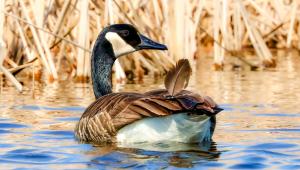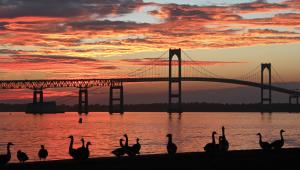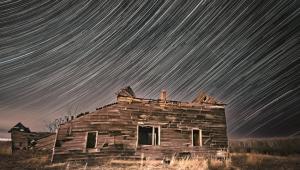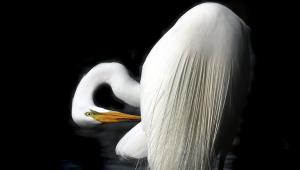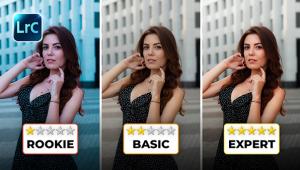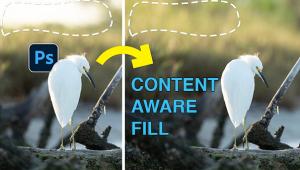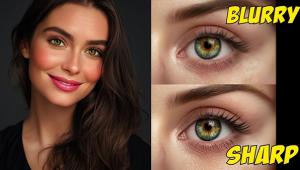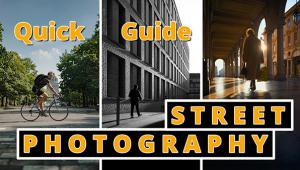The Ups and Downs of Using Imaging Drones For Aerial Photography

Courtesy of DJI
Drones! Remember the day when the word referred to male bees whose only role was to hang around the hive and fertilize the queen bee—in flight! They couldn’t even sting and, of course, died upon mating.
Today drones are better known as unmanned military aircraft that appear in the news with ever-increasing frequency. There was less coverage years ago when they were used strictly for surveillance. But now, as they fire ordinance on suspected terrorist targets, these high-tech vehicles are rewriting the rules of aerial warfare.
So it shouldn’t be surprising that consumer use of drones—albeit nonviolent ones—should evolve. Military technology frequently “trickles down” to the private sector.
Enter the quadcopter.

A single image made with a DJI Phantom 2 Vision Quadcopter with FC200 camera. “I shot this using the DNG Raw file. Using Adobe Lightroom 5, I was able to pull down the highlights and open up the shadows despite shooting directly into the sun.” - RJB
© Randy Jay Braun
Originally developed as a toy, several manufacturers have refined the four-bladed flying machines to the point that they serve admirably as still and video photographic platforms for photographers interested in aerial photography who prefer not—for reasons of cost, training, or fear of heights—to shoot from traditional aircraft or ultralights.
Standouts in the field include DJI’s new Phantom 2 Vision+, Walkera’s QR X350 Pro, Parrot’s AR Drone, and Storm’s Drone 6. Which unit to consider depends on several factors, including your photographic mission and, of course, what you’re willing to pay. The price range, depending where you buy, is $350-$1200. The best way to compare features is to check the manufacturers’ websites. Another good source of information and pricing is HeliPal.com, which bills itself as the “largest online helicopter store.” To get a handle on quadcopters as imaging platforms, Shutterbug sought the help of three expert quadcopter pilots/photographers.
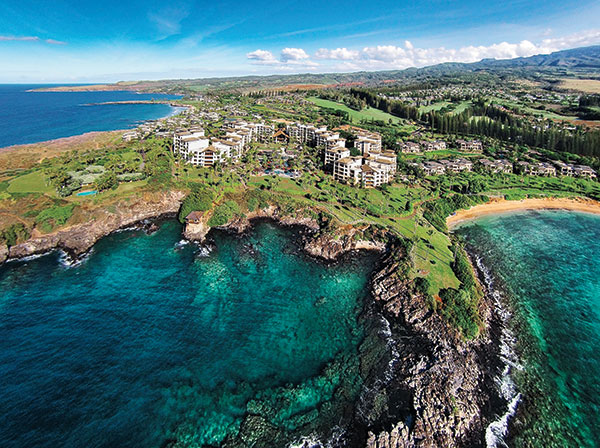
“I love the thrill of flying way out over the ocean. But I know three people who have lost drones in the ocean off of Maui, myself included. Still, the risk versus reward is often attractive.” - RJB
© Randy Jay Braun
Randy Jay Braun (www.randyjaybraun.com), Maui, Hawaii—Over the past 27 years, Braun has had a portrait studio, followed by 18 years as a successful gallery operator. Today he teaches and writes. He recently decided to learn about GoPro Hero cameras. He then bought a quadcopter. Aerial photography is now a growing percentage of his professional work—perhaps 25 percent. He recently published a book about small drone photography techniques—the first book on the topic (www.randyjaybraun.com/shop/aerial-drone-photography). In April, drone manufacturer DJI named Braun as the first “Visionary” in its new Aerial Drone Hall of Fame.
Julian Cohen (www.juliancohen.com), Sydney, Australia—Cohen is primarily an underwater photographer who has spent the last seven years photographing marine life of the Red Sea, Indonesia, and other locations. He was introduced to quadcopter photography by Eric Cheng, director of aerial imaging, DJI, when he met him in Tonga. He had been considering aerial photography. When he saw Cheng’s DJI Phantom he was hooked.
Romeo Durscher (romeoch.prosite.com), San Francisco, California—Durscher was born and raised in Switzerland and moved to California in 1997 hoping to work on a NASA space mission. Initially, he worked at Stanford University on one of the scientific instruments for the Solar Dynamics Observatory mission. In 2009, NASA asked him to provide education and outreach for the mission. He started doing photo projects and flying RC airplanes in 2007, switching to multi-rotor (quads, hexcopters, and octocopters) in 2012. He and partner Mark Johnson run Visual-Aerials.com.

“I have photographed whales from my kayak for seven seasons. I saw this one coming to check me out. Within 10 seconds I literally tossed my DJI Phantom 1 into the air before it even locked in GPS coordinates. I had set the GoPro Hero3 so it would shoot every two seconds. I didn’t realize the whale was next to me, because I kept looking up, trying to keep my drone under control. I nailed the shot pretty well. It is one of those iconic images a photographer dreams of.” - RJB
© Randy Jay Braun
Shutterbug: Have you used an aerial photography platform other than imaging drones? If so, what’s been your experience?
Randy Jay Braun: I have been hired to shoot from doors-off helicopters. It is always a rush shooting because the helicopter runs about $1600 per hour and the client begs for a quick shoot. The pilot can only hover in safe locations, and not too low or close to buildings. With drones, I can place my camera anywhere a bird can fly—between tree branches, in hotel courtyards, even inside large rooms with high ceilings. Imagine using a tripod that can extend 400 feet up. Essentially, a quality quadcopter is a magic tripod. GPS-assisted stability means one can capture panoramas simply by yawing slowly around the drone’s central axis. It sounds difficult but becomes simple after the first time you try.
Julian Cohen: Helicopters have the advantage of being able to stay airborne for long periods. Quads are time restrictive—about 20 minutes before the need to change batteries. Helicopters also allow the use of larger cameras and a variety of lenses. But they are big, noisy, and, for subjects such as wildlife, problematic. Although quads mainly carry small cameras, they are portable and far less expensive than other platforms. Yet they offer similar capabilities.
Romeo Durscher: The multi-rotor has the distinct advantage of being able to hover. The multi-rotor presents an easier-to-fly platform than traditional helicopters along with greater capability to recover from equipment failure. Hex and octo craft can lose a motor and still fly.
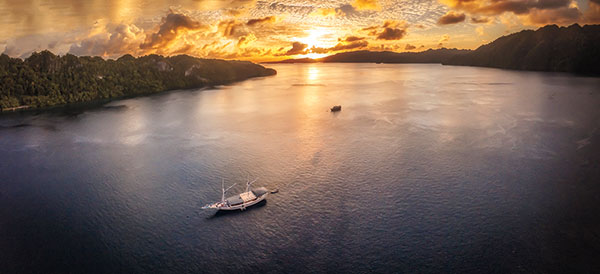
A five-image pano taken at 300 feet with a DJI Phantom Vision with FC200 camera. “I wasn’t sure how the sensor would handle shooting straight into the sun, so I chose a sunrise to avoid the sun coming out as a white ball. The DNG Raw files allow processing to reveal the colors in the sky as well as reflections in the water.” - JC
© Julian Cohen
SB: Do you shoot aerials for commercial customers or to sell? Or both?
Randy Jay Braun: Photographers are tiptoeing into commercial work with cautious optimism anticipating that the FAA will start issuing licenses to small-format drone flyers who want to operate commercially. In addition to some commercial work, I also produce gallery images and stock footage from around the world.
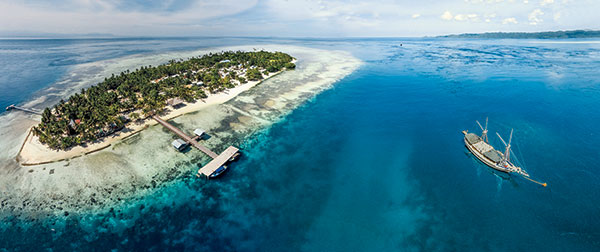
A four-image pano made at 170 feet with a DJI Phantom Vision with FC200 camera. “This region of Indonesia is dotted with beautiful islands in azure seas and was the main reason I decided to bring the quad with me on a dive trip.” - JC
© Julian Cohen
SB: For readers who are unfamiliar with quadcopters, can you briefly discuss their operation and limitations?
Randy Jay Braun: The new generation of quads has several built-in intelligent systems. They will lock-in to global positioning satellites and use them to reference their location. If I let go of the controls on the transmitter, the quad comes to a halt and hovers until I start moving the joysticks again. The quad will sit motionless in a wind up to about 23 miles per hour. I have made successful three-shot HDR captures in the wind. A drone pilot should keep the craft below 400 feet, stay at least three miles from airports, keep a direct line of sight to the craft, not fly over groups of people, and always be in complete control.
Julian Cohen: Many later model quads have a controller that prevents the quad from leaning over more than a set number of degrees when flying, thus keeping it stable and preventing flips. Before this, learning to fly a quad was as difficult as learning to fly a full-size helicopter. They also come with GPS that keeps them stable in three dimensions, adding to ease of flight for beginners. Quads are sensitive to wind and are best flown in calm conditions. Although they will fly in about 10-15 knots of wind, the calmer the better. Straight out of the box my Phantom will fly about 1500 feet. With additional modifications, it is possible to fly about five miles. The main limitation is battery life. The Phantom line has a proprietary battery that lasts 20-25 minutes, but most other quads have flight times around 10 minutes.
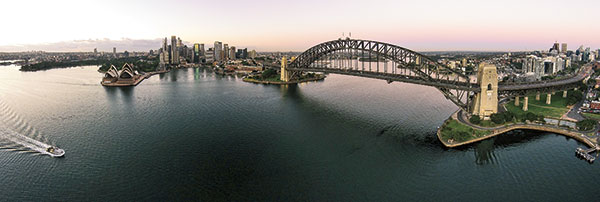
A six-image pano at approximately 300 feet made with a DJI Phantom 2 Vision with the FC200 camera. “I stood in a small park near the Sydney Harbour Bridge at dawn on a windless day. I flew out, grabbed the shots, and flew back in a flight lasting about 10 minutes.” - JC
© Julian Cohen
SB: Have you ever cracked-up a quadcopter?
Randy Jay Braun: Everybody has crashed at least a couple of times. I have had about five memorable crashes, all my own fault. Fortunately, a quadcopter adds up to a 2.5-pound pile of replaceable parts. Crashes teach humility. I fly much slower and more cautiously than I did a year ago, even though I am vastly more experienced.
Julian Cohen: I took my drone to Indonesia on a diving trip. One morning, as I flew about 300 feet over the sea, the quad dropped like a stone. I think one of the motors malfunctioned. Over land you can collect the pieces and repair it, but over water, even if recovered, it would never fly again. Salt water would have fried all the electronics.
Romeo Durscher: We have sometimes chased a shot knowing our battery power was borderline. This has led to losing power and landing in trees. Once we landed in a large oak tree near a homeless encampment. It was sundown so we had to leave it until the morning. Meanwhile, its bright locator LED flashed high in the canopy above. We wondered what those in the camp would think of the bright purple flashes high in the darkness.
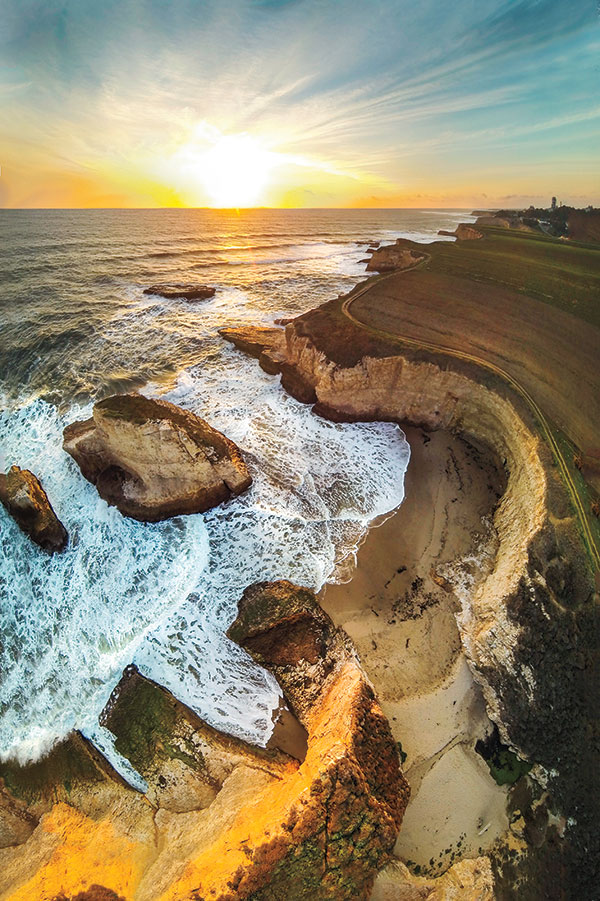
A five-image pano taken at about 330 feet from a DJI Phantom with a GoPro Hero3 camera. “I took the first image looking straight down, then tilted the camera slightly up for the next picture, and so on.” - RD
© Romeo Durscher
SB: What is your drone toolkit?
Randy Jay Braun: I fly DJI Phantom Quadcopters. My current favorite is the Phantom 2 Vision. It is stable, durable, and comes with the DJI FC200 camera attached. The camera is controllable with a smartphone on the ground. Not only can I see on my phone exactly what the camera sees, but I can adjust the exposure, color temperature, switch from JPEG to DNG (Raw), change my ISO, and point the camera in virtually any direction. Adobe software is my other tool. I generally begin in Adobe Lightroom and occasionally move into Photoshop CC. The attached DJI cameras actually have DNG Raw and JPEG shooting options. Raw file processing is where the magic happens. Adobe engineers were quick to develop lens profiles for both the DJI FC200 camera and the GoPro Hero3. There is a simple one-button lens distortion correction feature both in Lightroom and Photoshop.
Julian Cohen: I use a DJI Phantom Vision. Its camera has 14 megapixels and an f/2.8 fisheye with a 140-degree field of view. The main advantage is the camera will shoot Raw, allowing plenty of processing power. One has to be realistic and not expect the small sensor to produce poster-size images. But for web use or a magazine double-page spread, it is eminently capable.
Romeo Durscher: We fly a DJI Phantom 2 Vision+ that has its own proprietary camera and gimbal system. We also fly a Phantom 2 with a GoPro Hero3+. Our larger hex and octos fly a Zenmuse Z15 gimbal by DJI with a Panasonic Lumix GH4 camera. The gimbal is optimized for the Olympus M.Zuiko 12mm f/2.0.

A six-image pano made with a DJI Phantom with a GoPro Hero3 camera. “We launched from the river, went straight up, and took this series of images. The entire flight was only four minutes.” - RD
© Romeo Durscher
SB: What improvements, if any, would you recommend for quadcopters used in photography?
Randy Jay Braun: I wish I had a choice of focal length. The small action cameras have a 140-degree field of view that is often too wide. I actually purchased a custom-built GoPro Hero3+ with a long lens from RageCams.com. Having a built-in zoom would be nice!
Julian Cohen: Longer-lasting batteries. DJI’s Phantom 2 and Phantom Vision were the first with batteries allowing 20+ minutes of flight time. The ideal would be to be able to use a full-frame DSLR in a quad that can fly for an hour and is easily portable. That might sound a stretch, but I wouldn’t be surprised to see it within a couple of years.
Romeo Durscher: Improvements in battery technology will change everything, allowing us to carry heavier cameras and lenses for longer flights. The DJI Phantoms with the GoPro Hero3+ can fly approximately 22 minutes. Obviously, the camera sensors and lenses are limiting, but trumped by low weight and long flight time. We can fly a Canon EOS 5D on our heavy-lift copters, but suffer from short flight times. Thus, we fly the Lumix GH4 as an acceptable substitute.

A single image at about 200 feet made with a DJI Phantom with a GoPro Hero3 camera. “After a two-hour hike upstream into the canyon, we flew straight up and shot straight down. There was no GPS reception and winds made it challenging to keep the drone centered.” - RD
© Romeo Durscher
SB: What recommendations would you make to someone considering buying a quadcopter?
Randy Jay Braun: Take a class or learn from a friend. I teach classes in aerial photography in Hawaii, and I know many cities have frequent social meetups. Expect to spend about $2000 for everything you will need to get started. That includes extra batteries, extra props, and a carrying case. Don’t forget that you will need to process drone photos. Adobe Lightroom Version 5.4 or later comes with lens correction profiles for both the DJI FC200 camera and GoPro Hero cameras.
Julian Cohen: Learn to fly first. The best entry model would be something like a Blade Nano QX, available for about $100. Although palm-sized and without a camera, it reacts and flies the same as a full-size quad. If you can fly it, you can fly anything and will not have to depend on GPS mode in the bigger quads. GPS is great for stabilized photography, but I believe it is better to be able to fly without it to have more control.
Romeo Durscher: We recommend that anyone serious about aerial photography pick up the DJI Phantom 2 Vision+. For a single price you get a turnkey product that flies right out of the box—complete with three-axis gimbal, camera, and radio controller. As with anything technical, it’s a learning experience. However, the Phantom is easy to learn and, with GPS technology, produces professional results.
Drone Origins
Military historian Steven Zaloga, in Unmanned Aerial Vehicles, explained how drones got their name: “In 1935, U.S. Adm. William H. Standley saw a British demonstration of the Royal Navy’s new remote-control aircraft for target practice, the DH 82B Queen Bee. Back stateside, Standley charged Commander Delmer Fahrney with developing something similar for the Navy. Fahrney adopted the name ‘drone’ to refer to these aircraft in homage to the Queen Bee.”
- Log in or register to post comments


